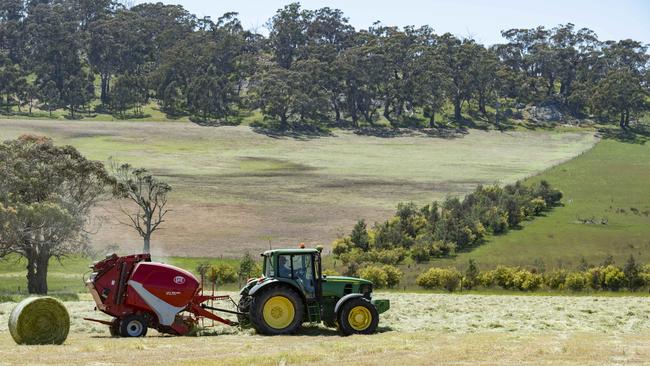Falling numbers test on wheat can increase, if stored correctly
Preliminary research has been done to help grain growers store wheat in the best way to improve its Falling Numbers Test to milling grade.
GRAIN TALK
After a decile one growing season rainfall and several damaging frosts during flowering of cereal crops, rain at harvest is threatening grain quality and returns.
Despite what appears to be a perfect storm of events that collude against growers, there are some positives that some believe will deliver better than expected returns this season.
Growers between Nullawil and Charlton have received 93mm in two to three rain events since the summer storms began on November 24 and those near Swan Hill have received 71mm.
The heavier falls have been during November and in the northern regions of Victoria.
These falls over a 12 day period, combined with maximum temperatures averaging over 30 degrees has caused damaged to many wheat crops.
According to growers, most of the barley has been harvested in the Mallee and wheat is still exposed.
A strategy that many growers have adopted in the past is to deliver their milling quality wheat and store any wheat that falls below 300 seconds for the Falling Numbers test. This test assesses the development of alpha amylase enzyme that can render starches in wheat unsuitable for baking.
Growers have learnt that the Falling Numbers test can increase over time indicating a fall in the level of alpha amylase and an improvement in quality.
As growers are achieving Hard 1 or Hard 2 grade this year, A Falling Numbers test under 300 can mean a $50 to $60 a tonne lower price.
There is scientific support for this.
Factors such as temperature, humidity and oxidation during storage can cause levels of the enzyme to degrade over time.
Ironically, the higher the temperature and moisture of the stored grain, the faster the breakdown of the enzyme and the more likely wheat testing between 250 and 300 seconds will be reclassified as milling if delivered in six months’ time.
When the falling number of wheat improves in storage, the quality improvement is genuine and baking quality improves.
There is a conflict here with the conventional best practice.
To retain the quality of grain and avoid fungal and insect growth, the prime objectives of grain storage are for a cool and dry environment.
The GRDC in conjunction with Agriculture Victoria have undertaken some preliminary research into this issue to provide growers with some recommendations to resolve this contradiction.
A media release of the key findings is expected this week but the key findings suggest for wheat testing between 250 and 300 seconds at harvest and stored between 25C and 30C for four to six months, there is a good chance that the wheat will achieve milling classification of 300 seconds or above while having a good chance of avoiding fungal and insect infestations.
The preliminary research suggests that wheat behaves in this manner but there is no evidence that barley behaves the same.
For further information see storedgrain.com.au or grdc.com.au

HAY TALK
The late rain is improving prospects for late silage cuts and providing further limits on any price hikes in hay prices.
The 35mm to 50mm of rain that has fallen this month equates to the entire monthly average in many parts of the Riverina, northern and western Victoria. These moist and warm conditions have been ideal for grass pastures in Gippsland and the Western District and graziers are preparing for their second silage cut on some refreshed paddocks.
Livestock producers near Donald have even planted sorghum as a summer forage crop.
The rain has caught some grain growers with frosted cereal hay paddock stacked six bales high. Top bales that have received 50mm since mid-November have been discounted to under $180 a tonne to clear stocks before further rain to more damage.
There is a lack of intensity in the pace of hay traded.
Cereal hay discounted to $250 a tonne ex farm or less is still finding buyers but most sellers are focused on harvesting grain in the difficult weather and many livestock producers are still engaged in hay and silage harvest.
Within this price range of $250 to $260 a tonne ex Mallee farm, there are still some parcels of excellent quality testing 10 ME units of energy and 10 per cent protein.
These parcels of hay are of interest to hay exporters.
Exporters are finalising their delivery programs for their contracted growers and some are looking to top up their inventory with non-contracted hay, especially those in South Australia.
Stagnated demand in international markets and a challenging exchange rate have capped prices. These factors will restrain exporters in chasing expensive hay on current markets.
Like the cereal hay market, and unlike the past two seasons, there are some parcels of vetch with excellent feed tests. Large parcels of 600 tonnes of vetch testing over 10 ME units of energy and 20 per cent protein are offered at $350 a tonne ex farm near Werrimull.
In a year of decile one growing season rainfall for many grain growers, it’s the small gains in soil moisture that are making a big difference in crop yields. Lentil crops sown on oaten hay paddocks cut well before grain development, have yielded as high as 2 tonnes a hectare, much better than neighbouring paddocks of lentils that were sown on cereal grain paddocks.
While there is an increased volume of cereal hay available to buyers this season, key price factors remain the historically low carry-over stocks and the timing of the autumn break.





